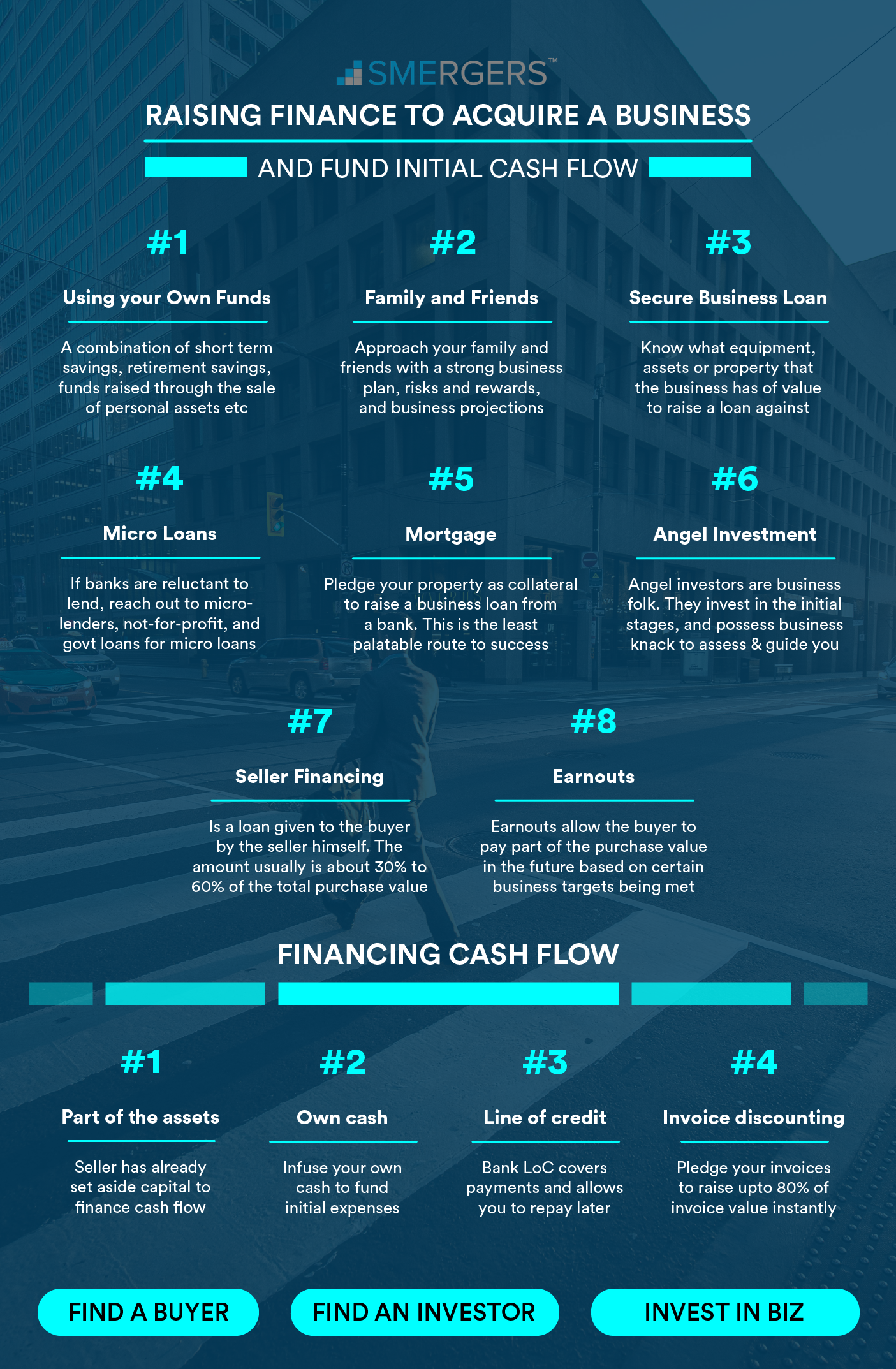Entrepreneur's Guide to Raising Finance for Business Acquisition and Funding Initial Cash Flow
What’s in this guide: with nearly a decade's worth of experience in business financing, franchising, and business selling, we at SMERGERS have a tried and tested guide to help entrepreneurs raise finance for business acquisitions. This guide covers all three aspects of business financing, beginning with closing costs, varieties of financing options, and funding operational expenses.

Technology, skilled labour, and business-friendly reforms have turned the majority of the world into a fertile incubator to start businesses with ease. An ever-growing middle class, increasing population, the mass exodus of people from rural areas to big cities are demanding access to sophisticated products and services, more than ever before. This is the case in North America, China, India, and the rest of Asia.
This inflated demand is taking even the conglomerates and big businesses by surprise. In the olden days, major corporations had all the time to wait for their R&D to invent new products and services, and then their management to turn them into lucrative businesses.
That luxury of time to turn patent into profit is diminishing today. Hence, most businesses have embraced the idea of acquiring businesses if it suits their business vision and ideally adds to the profit margins. To put it in simple terms, there are more business mergers and acquisitions today, than ever before since the industrial revolution.
If you are an entrepreneur or a mid-market company trying to acquire another business, this guide will help you understand the varieties of ways you can raise funds to buy a business if the following factors are met:
- You have already chosen or shortlisted a business to buy
- The chosen business is in operation
- You have funds to cover the closing costs of business financing
Though the internet is awash with courses and guides about buying a business with no money down, this rarely occurs in the real world. As a buyer, you need to factor in the transactional cost of raising finance and choosing the best modes of financing to cover the larger part of acquiring the business.
This closing cost usually factors between 10% to 20% of the total purchase cost. It is quite rare for a buyer to fund a business acquisition from a single source of finance. Let us look at the types of financing available.
Types of financing options to acquire a business
As mentioned earlier, buyers use multiple sources to fund an acquisition. Combining own funds from savings, raising money from friends and family to applying for a bank loan to cover the purchase and initial operational cost. Here are 8 common ways to raise finance to acquire a business.
1. Utilizing your own funds
Utilizing your own funds is the simplest way to acquire a business. This can be a combination of short term savings, retirement savings, funds raised through the sale of personal assets etc. Although no business acquisition can occur with 100% outside financing, you will have to put your own funds to use to cover the initial transactional costs of acquiring a business.
SMERGERS tip: use your own money to fund the initial costs of acquiring and raising finance.
2. Raising funds from family and friends
Your family and friends have your best interests at heart and it may bode well to borrow money to fund your business acquisition through them. If you are acquiring a small business securing a good percentage of the purchasing cost via family and friends is one of the best options. If the purchase is for a medium or large scale business, this may not be the only source to raise funds.
SMERGERS tip: approach your family and friends with a strong business plan, risks and rewards, and business projections. This way you make the deal transparent and help them make informed decisions. You also need to consider how the funding arrangement will be structured. Are you offering equity? Or will this be a loan? Hire an M&A advisor, they come in handy in structuring financing deals.
3. Raising finance through secure small business loan
There are a variety of financial institutions that offer secured business loans, ranging from banks to NBFCs (Non-Banking Financial Corporations). The availability of such loans is sensitive to macroeconomic performance.
If the economy is doing good and growing at a consistent pace year-on-year, access to bank loans is relatively easy. Stagnation in consumer markets makes banks very cautious about lending money to businesses, as they see no uptick in sales.
Most small business loans are secured against the assets of the business. If you are buying a small business, you will need to know what equipment, assets or property that the business has of value. Banks may also assess your (individual) financial health and capacity to repay the loan.
SMERGERS tip: Financial institutions need a strong business plan, business financials, projections, clear list of business assets and liabilities for anyone to qualify for a secured loan. Loan processing and approvals are laborious tasks, allow yourself a month's time (minimum) to get a loan. Prepare a business dossier of all necessary documents and be patient.
4. Raising finance through a microloan
Many banks are reluctant to lend without collateral or if the investment environment is dire in the wake of a credit crisis. This doesn't mean you should lose hope. Such a situation is ideal to approach microlenders to raise a loan. These institutions are often backed by local, state or federal governments, ideally to boost local business and employment. Microloans are often so small that commercial banks can't be bothered lending the funds. Instead of a bank, you need to turn to a microlender. These small ticket loans usually require less documentation when compared to banks, and often provide flexible underwriting criteria.
SMERGERS tip: Microloans are ideally designed and lent to startups or businesses in emerging, environmentally friendly markets. Assess if your business qualifies under such categories and reach out to respective microlenders. A qualified Debt advisor can help you assess the best microlenders suitable for your business.
5. Raising finance through mortgage
This mode of raising funds happens when you pledge your property as collateral to raise a business loan from a bank. This is the least palatable route to success. Since you are raising funds to buy a business, your bank may want to see your business plans, projections etc.
SMERGERS tip: raising funds through a mortgage-backed business loan requires a ton of paperwork. This will be a lengthy process. You may combine other forms of raising funds with this method. But solely funding the acquisition via a mortgage-backed loan isn't a common occurrence.
6. Raising finance through Angel Investment
Angel investors are themselves businessmen and businesswomen or have been in the past. They usually invest in the initial stages of a business and come with a strong business knack to assess and guide businesses. If your business plan and execution is foolproof, it is easy to attract Angel investors.
SMERGERS tip: since Angel investors are usually experienced in the industry they invest in, you should be on high alert to draw a robust business plan, as every element of each business function will be scrutinized.
7. Seller financing
Seller financing is a loan given to the buyer by the seller himself and is a very common form of financing in developed countries as there is reasonable trust between the buyer and seller. The amount usually is about 50% to 70% of the total purchase value. Seller financing is a blessing for the buyer as he/she gets easy and immediate access to capital. And a seller would attract a larger pool of buyers and can demand a higher sale value by offering partial financing to the buyer.
SMERGERS tip: Seller financing needs a thorough valuation of the business. The buyer needs to understand if the business is not overvalued. And the seller needs to get a better selling rate as he/she is willing to offer financing. This is where you need M&A advisors to conduct a proper business valuation.
8. Financing acquisition through earnouts
Sellers usually account for future growth potential in the business sale value. However, from a buyer's perspective, EBITDA multiples based on historical numbers play a major role.
In such cases, you - the buyer - can structure the deal which includes earnout provisions. In an earnout, part of the purchase price is paid to the seller at a specified future date after the closing, based upon the company achieving specific performance goals.
Earnouts allow buyers to mitigate risk while positioning the seller to benefit from company growth after the sale closes, and receive a payment if and when the company achieves specific goals.
SMERGERS tip: Earnout negotiations are often complex and tough to arrive at. Hire M&A advisors to help you chart the right earnout strategy and structure.
How to finance your business operations
Once you have successfully raised finance to acquire the business, you would need adequate capital to manage day-to-day operations. With salaries, production, sales and marketing, accounting, international payroll services, etc. all business functions needing cash to run and survive on a daily basis. It is always wise to acquire a business where the seller has set aside a decent amount of capital to finance day-to-day expenses. Ensure the seller does not squeeze out the average working capital levels maintained in the business before transferring it to you. However, if you wish to add funds to boost initial cash flow yourself, here are three ways to fund your operational expenses.
1. Financing operations via business cash flow
This is the easiest way to finance day-to-day expenses. However, any business becomes robust when its own cash flow starts paying for its expenses.
SMERGERS tip: draw vendor contracts with net-30 or net-60 day pay terms rather than paying immediately, this will give you enough legroom to accommodate large and late-paying clients.
2. Financing operations via Line of Credit
A line of credit from your bank allows you to pay immediate expenses while having the luxury of paying back when cash flow improves. However, qualifying for a line of credit is subjective to the bank and your industry of operation.
SMERGERS tip: apply for a line of credit with your bank. Share all the necessary financial documents to help them assess you better and sooner.
3. Financing operations via invoice discounting or invoice factoring
When you raise an invoice to your client and receive an acknowledgement, your invoice becomes a legal covenant for guaranteed payment from your client. The trouble is that most of your clients pay on net-30 or net-60 day payment terms. Locking up all your cash for a long time.
Invoice discounting allows you to encash nearly 75% to 80% of the invoice value immediately, and the remaining upon the payment of the invoice in question. There are many NBFCs that offer funds against invoices. And this is the easiest and reliable way to increase your cash flow consistently.
SMERGERS tip: financial institutions are always keen to fund reliable businesses, ensure to verify and negotiate on terms and conditions before factoring your invoices to boost your cash flow.
How important are M&A advisors
Do you need professional advice to help you raise funds from the best sources, with one eye on sustaining your business? The answer to this question is an assertive yes. Business acquisitions are made through multiple sources of funding.
Professional M&A advisors come with decades worth of experience in helping entrepreneurs and businesses raise funds from multiple sources and close deals. You need someone who understands the entire, cumbersome process of combining the best sources to raise funds.
From assessing the best business and their financials to drawing the right legal documentation, M&As require a lot of due diligence to be conducted at every step of the transaction. We created SMERGERS to be a platform where business sellers, buyers, investors, advisors, and M&A lawyers connect with each other seamlessly. We have levelled the playing field of M&As with a robust network of all stakeholders within the M&A sphere.
At SMERGERS, we have helped 100s of businesses and entrepreneurs invest in and acquire businesses in a smooth, transparent manner. We have earned our reputation for our systematic workflow which helps you reach your desired business goals. Visit www.smergers.com and register, interact with advisors and investors today.





































